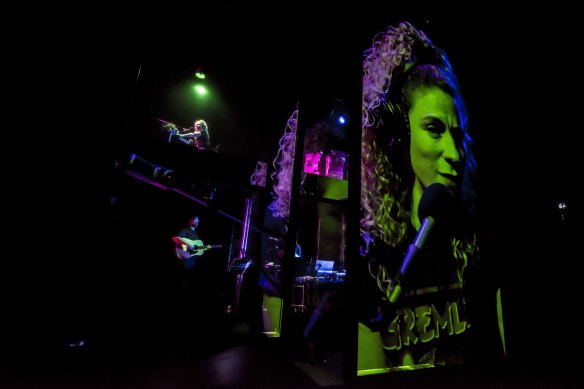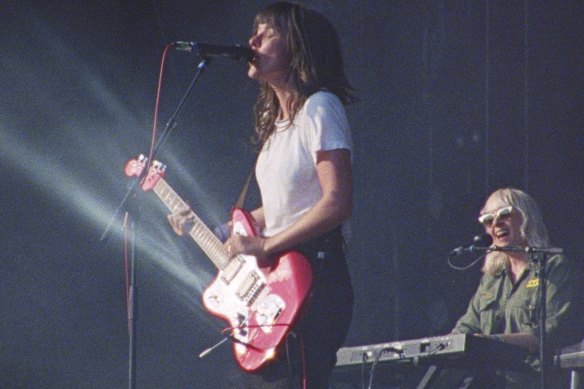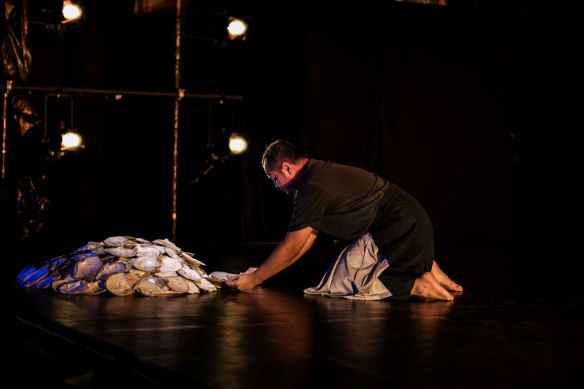This was published 9 months ago
This play tells you to trust nothing – including theatre
By John Shand, Harriet Cunningham and James Jennings
THEATRE
Things Hidden Since the Foundation of the World
Opera House Drama Theatre, January 19
Until January 21
Reviewed by JOHN SHAND
★★★★
An audience address becomes a play without you noticing. But Javaad Alipoor’s work questions the nature of a play, just as it questions the internet’s deception that everything can be known, or how a refugee pop star becomes a murder victim, or what it means to be Iranian but unable to live in Iran.
Alipoor, a Briton of Iranian descent, co-wrote the show with Chris Thorpe, directed it and stars in it, playing himself. As a performer he has such fizzing presence that if he told you Trump was the messiah you’d briefly consider the proposition. Instead, he toys with ideas, preconceptions and your capacity to question your own powers of interrogation.

Javaad Alipoor’s work questions everything, including the nature of a play.Credit: Chris Payne
He tells of Fereydoun Farrokhzad, Iran’s shah of pop and TV – “the brightest star, albeit in a smaller sky” – before 1979’s Islamic Revolution, whereupon he fled to Germany, and died a violent death in 1992. He likens Farrokhzad’s mass appeal to that of Tom Jones in his heyday, while later emphasising the futility of defining anyone as being like another.
Enter Asha Reid, who plays a podcaster with a show called Death in the Gaps, purporting to investigate mysterious unsolved murders. She presents the known facts about Farrokhzad’s death, and hypothesises about how and why he was killed. We also meet Raam Emami (playing himself), better known in Iran as King Raam, a musician and songwriter whose father was killed by the regime, and who lives in Canada, where he has been told he’s on an Iranian death list.
Across 90 minutes the show pulls focus between these three “characters” as we’re drawn deeper into Farrokhzad’s case, while also learning to question what we’re being told. It uses projections ever more elaborately, with live music by Emami and multi-instrumentalist Me-Lee Hay.
On one level it’s a staged documentary that disguises its own shrewdly dramatic structure, culminating in Alipoor and Reid recreating a credible version of Farrokhzad’s death. If Reid’s contributions were initially the weakest link, by this point she’s joined Alipoor in transfixing you.
Yet it’s all just a hypothesis – in a play begging you not trust hypotheses, similes, Wikipedia or even itself. It contains profundities and inanities masquerading as profundities, yet you forgive the latter and absorb and relish the former because the show crashes through its own rules and obliterates anyone else’s.
MUSIC
Courtney Barnett
City Recital Hall, January 20
Reviewed by JAMES JENNINGS
★★★★
In terms of a musical about-face, Courtney Barnett – the Australian singer-songwriter known for wry, observational storytelling – releasing an album of improvised, instrumental guitar music isn’t quite “Dylan goes electric”. But it’s enough of a pivot to warrant curiosity about how her music fares minus the witty wordplay.
This night’s show is split into two sets, the first featuring the aforementioned six-string noodling that was created for a 2021 documentary on Barnett called Anonymous Club, which in turn became last year’s soundtrack album End of the Day.

Courtney Barnett’s music from the 2021 documentary on her, Anonymous Club, became last year’s album End of the Day.Credit:
Set one kicks off with Barnett and multi-instrumentalist Stella Mozgawa (from American alt-rockers Warpaint) silently, stoically taking to the stage to reverently coax extended notes out of their instruments in front of a giant screen featuring Barnett in a blue raincoat walking through hilly countryside.
If you think tracks named Floating Down and Spring Ascends hint toward ambient meditation music, you’d be bang-on. For 30 minutes the sounds repeatedly build, recede and conjure a dreamlike state via subtle moments: Barnett playing her guitar with a bow, or standing to build feedback from a bluesy riff; Mozgawa’s synth playing backwards in surround sound.
After a brief interval a solo Barnett beatifically bounds back onto the stage for set two as though she’s just switched places with a serious-art twin who doesn’t do smiles. Courtney v.2 is chatty and charming: “Hello, good to see you! Don’t be afraid to make noise!” she implores before launching into a selection of choice cuts from her back catalogue.
Even with just guitar and voice Barnett is a compelling performer, one who knows how to combine the right playing style, chord progression and turn of phrase to ensure the whole is always greater than the sum of its parts.
A master at making the mundane sound magical, Barnett puts her exceptional storytelling skills to use in Avant Gardener (“It’s a true story – except the bit about getting a shot of adrenaline to the heart. I stole that from Pulp Fiction,” she tells us), break-up dissection Need a Little Time and Depreston, a song about buying a house that’s as gripping as any prestige-TV drama.
A half-hour of hypnotic guitar followed by top-shelf indie rock peppered with funny banter may sound like musical whiplash, but it’s to Barnett’s credit that she pulls both off with aplomb, the standing ovation at the finale more than deserved.
DANCE
Mutiara
Seymour Centre, January 20
Until January 21
Reviewed by HARRIET CUNNINGHAM
★★★★
The stage is bare, but for a pile of discarded shells and a square column of thick ropes, hanging to the floor. A figure walks in, holding something. It could be a phone, the way its surface catches the light, but no, it is the milky iridescence of mother-of-pearl. He puts it on the pile. And so begins Marrugeku’s new work Mutiara, a co-created collaboration that explores Broome’s pearling history through the lived experience of Ahmat Bin Fadal, an ex-pearl diver.
Excerpts from Lustre (a Western Australian Museum 2021 exhibition) are displayed in the foyer, and the archival photos and oral histories bring home the intercultural nature of the industry, which sucked Malays, Chinese, Japanese, Pacific Islanders and Aboriginal and Torres Strait Islanders into the dangerous extractive industry that boomed from 1860. Mutiara embodies this interculturality, with the four performers expressing their individuality and their interdependence with gripping physicality.

Mutiara explores Broome’s pearling history through the lived experience of Ahmat Bin Fadal, an ex-pearl diver.Credit:
Detail is everything: a tiny gesture tells, with fragments of Indigenous, traditional, martial arts and improvisation making a dense mixture of ritual and story-telling. There is the Bomu, an amorphous harbinger of chaos. Then there is a young interracial couple, dancing the twist, having a ball. Then there are the divers, with lead boots and faceless globes for heads, dragging their feet in the dreamlike depths. Most affecting is the involvement of Bin Fadal, who moves with solemn grace, his presence turning scratchy photos and historical texts into living memory.
The staging (with set designed by sculptor and artist Abdul-Rahman Abdullah) and lighting (Kelsey Lee) is highly effective: the rope column unfurls to become layers of ropes, curtains through which we see the pearl divers and on which we see archival footage of the pearl luggers at sea. Meanwhile, an intermittent voice-over, the voice of White Australia, gives chilling context.
It takes time for Mutiara to give up its stories. I’m thinking about it, turning over the graceful physicality of Ahmat Bin Fadal, for a long time after the lights go down. History walks among us if we pause for long enough to see it, hear it, and Mutiara asks us to pause, look, listen.
The Booklist is a weekly newsletter for book lovers from books editor Jason Steger. Get it delivered every Friday.